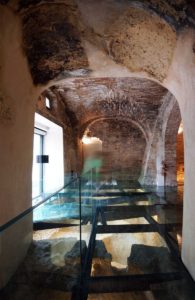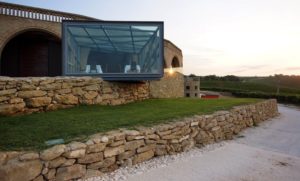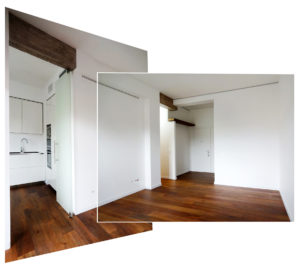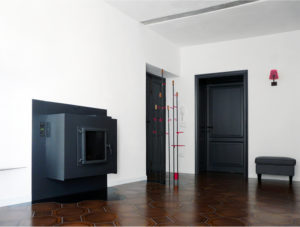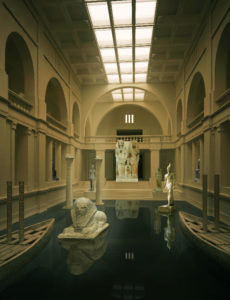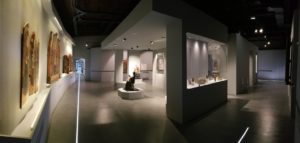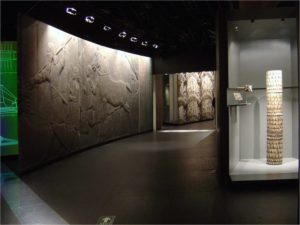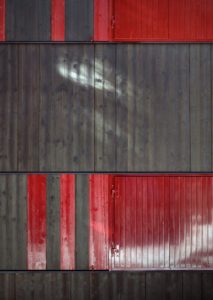La torre di Porta Gabella fa parte dell’antica cinta muraria a difesa della città di Ripa Teatina. Il restauro lo ha trasformato una struttura espositiva, gli elementi aggiunti sono delle passerelle in acciaio e vetro per permettere l’accessibilità e lasciare a vista le testimonianze architettoniche emerse in fase di restauro.
La cantina nasce dalla necessità d’inserire, in prossimità della seicentesca villa padronale esistente, un nuovo grande spazio di oltre 4.000 mq, senza stravolgere l’armonia del paesaggio e dell’architettura storica esistente. La struttura ha le stesse caratteristiche delle antiche cantine presenti al piano seminterrato della villa, con limitati sbalzi termici e materiali in grado di controllare naturalmente il grado igrometrico degli ambienti. Si è scelto una struttura semi ipogea, con il lato curvo affiorante che si affaccia a nord e la copertura che diventa il giardino della villa. All’interno la cantina si articola su 3 livelli: il piano terra, una terrazza belvedere con vista mare; Il primo seminterrato con la sala degustazioni, la bottaia, visibile dalla sala, lo spazio a tutt’altezza della cantina e gli spazi di servizio. La sala degustazioni, ristorazione con la vista aperta sulla vallata e sul mare è caratterizzata dal controsoffitto in lastre di corten, la cui orditura rievoca l’immagine dei campi arati e un pavimento in cemento bianco lucidato. La sala si articola su due livelli, con la parte bassa, complanare alla bottaia, che si proietta all’esterno in un box in acciaio e vetro, sospeso sui vigneti. L’involucro è costituito solo da acciaio e vetro con un pavimento in sassi, metafora delle vicine spiagge di sassi. I giochi di luci esaltano l’effetto notturno. Il secondo seminterrato ospita lo stabilimento produttivo vero e proprio Il soffitto in corten oltre ad una funzione estetica spaziale, funge da correttore acustico e da struttura portante x l’illuminazione completamente realizzata con strip led. I materiali utilizzati sono legati al territorio: la pietra arenaria, il mattone e l’acciaio corten uniti al vetro, che proietta il paesaggio all‘interno della struttura. La parte emergente è caratterizzata da tre involucri: -il più esterno, con muri a secco in pietra arenaria locale, che formano dei terrazzamenti a pianta libera, è l’elemento di continuità con l’ambiente circostante; -quello intermedio, una serie di grandi arcate in mattoni, metafora dei muri di sostegno ottocenteschi, funge da elemento di continuità architettonica con la villa; -quello interno, in vetro e acciaio, è l’involucro tecnologico contemporaneo con un suo andamento planimetrico.
La realizzazione del nuovo punto di vendita enogastronomico è stata l’occasione per creare uno spazio espositivo e di degustazione che riassuma in se la tradizione e l’innovazione. Il recupero e restauro in un fondaco completamente buio ed interrato di un palazzo degli anni venti in Ortona è stata l’occasione . L’idea è stata quella di ricreare la sensazione e l’illuminazione di uno spazio “esterno “ in uno interno.; la scenografia è una metafora del paesaggio costiero abruzzese, con spiagge di sassi bianchi , pontili in legno, ed acqua. Al piano strada i proiettori filtrati da reti in acciaio come metafora delle reti dei trabocchi , le luci che nascono dai sassi a terra inseriti in canne di bambù rievocano paesaggi tipici delle foce dei fiumi. Gli ambienti sono stati ridisegnati dalla luce, il locale si articola su più livelli aperti. collegati con una scala elicoidale in acciaio vetro e legno ed un ascensore vetrato. Un piano terra un soppalco, dedicato alla vendita di prodotti gastronomici tipici e di qualità ed uno interrato alla degustazione, all’enoteca, al caffè e al cioccolato. La luce naturale nel sotterraneo arriva attraverso un vuoto ed un piano in acciaio e vetro inserito in sostituzione del solaio esistente, il chiaro scuro della luce naturale èi integrato da luci artificiali a pavimento e verticale.
La villa in collina con vista mare nasce dalla ristrutturazione ed ampliamento da un fabbricato rurale degli anni venti e dai suoi annessi agricoli, riaggregati attraverso l’inserimento di nuovi volumi. I volumi aggiunti e ricostruiti sono ispirati a elementi di architettura rurale abruzzese di inizio novecento, alternati ad altri dal taglio più contemporaneo. I nuovi spazi residenziali si articolano su tre livelli con affacci diretti sulla collina a degradare sistemata a giardino terrazzato con piscina. Il piano seminterrato con accesso diretto dal giardino è illuminato da ampie vetrate. Nella parte più interna il grande soggiorno è caratterizzato dal taglio nel solaio che permette il passaggio dalla luce dalle vetrate del piano terra .
Appartamento LS
70 mq
Roma
Old town centre apartment refurbishment and renovation.
Scansano | Tuscany
75 smq
Progettazione del Masterplan del Museo Archeologico Midan Tahrir del Cairo e dell’ allestimento museale pilota (nell’ambito del programma di “Riqualificazione del sistema museale Egiziano – Convenzione MAE- DGCS/MiBAC – Segretariato Generale)
L’Aquila _ allestimento delle opere del Museo Nazionale d’Abruzzo nei locali restaurati e ristrutturati dell’ex Mattatoio de l’Aquila nell’ambito del Progetto Pilota Strategico “Poli Museali di Eccellenza nel Mezzogiorno” (Convenzione del 22-02-2006 stipulata tra il MiBAC e INVITALIA).
Cina_Beijing – World Art Museum – Mostra “Mirroring the Age”: Men and their World through six centuries of Italian Art Works in the Florentine State Collections”_ accordo tra il Beijing World Museum – Ministero BAC – Soprintendenza per il Polo Museale Fiorentino – 20 Gennaio- 10 maggio 2006
Inaugurazione della Mostra “The Great Civilization”(Egiziana, Mesopotamica, Indiana, Maya, Greca, Romana) accordo tra il Beijing World Museum – Ministero BAC – 28 settembre 2006 – 28 settembre 2008
ESTERNI: geometrie intorno al colore rosso La composizione dell’edificio esistente si configura attraverso un sistema a fasce organizzate per piano. (PT/pietra, 1°+2°/intonaco bianco, sottotetto/legno scuro). L’unico elemento sempre presente è l’antone di oscuramento di colore rosso. Il progetto prevede il mantenimento del colore come elemento fisso, elemento della memoria. In questo modo, l’edificio sarà sempre riconoscibile come la “casa con le finestre rosse”. Il progetto lavora invece sull’articolazione dei rivestimenti lignei che vengono ampliati nella loro misura. Visto il volume dell’edificio, tendenzialmente “cubico” si è deciso di articolare il rivestimento mediante una prevalenza di linee verticali e mediante un gioco di superfici geometricamente date, di sfalsamenti e svuotamenti. L’immagine finale, cancella l’organizzazione a fasce, a vantaggio di un rivestimento ligneo di linguaggio contemporaneo. In alcuni casi, il rivestimento disegna una cornice intorno al serramento, capace di accogliere al suo interno anche gli scuri aperti.La facciata est, interamente lignea, con una regolare scansione delle aperture viene risolta ampliando, oltre la consueta misura, il colore rosso. Un codice a barre, una decorazione, organizza per fasce orizzontali la facciata. INTERNI: composizione dei risvolti Il progetto si sviluppa attraverso il riconoscimento di elementi caratterizzanti che diventano immediatamente vincolanti. All’interno, innanzitutto, si rileva la validità della distribuzione interna. Il progetto parte da un atto “non progettuale”; la scelta di non intervento sposta l’attenzione su un diverso piano progettuale. La nuova pavimentazione, in listoni di rovere, diventa elemento generatore della forma. Essa sale sulle pareti, si piega e riempie alcune porzioni di soffitto. Nuove geometrie, in forma quasi autonoma, si giustappongono e ridefiniscono la percezione dello spazio interno. Un elemento nuovo, il colore rosso, si inserisce come indizio, come legame. Porzioni scavate di mobili o bande colorate in movimento sulle ante di un armadio, diventano elementi di connessione diretta con l’esterno.
